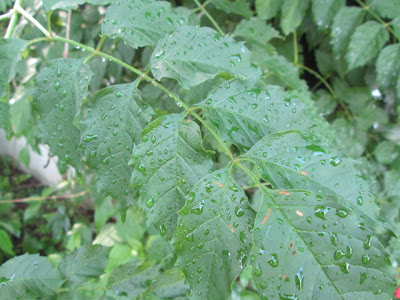Campsis radicans & Lonicera sempervirens

Ken & Paula Korber - Trumpet Honeysuckle

Last fall Paula and Ken Korber, friends of mine from the Frostville Farmer's Market introduced me to the native Trumpet Honeysuckle - Lonicera sempervirens. I assumed that this plant was the same as the "Trumpet Vine" that I had been growing in my yard for years. I recently learned this was not the case.
Both Native Vines
Trumpet Creeper & Trumpet Honeysuckle
As it turns out both plants are native to the United States. The USDA Department of Natural Resource indicates Trumpet Creeper - Campsis radicans range extends further west; their maps mention that Trumpet Honeysuckle is endangered in the state of Maine, USA. Both are perennial vines in zone 4 - 9, enjoy full sun with the Trumpet Creeper tolerating partial shade neither are particular to a specific soil type in which they flourish.
 |
| Trumpet Creeper can grow up to 40ft. |
Different Family Traits
Plant families remind me of our human families, each having characteristics that distinguish them from other neighbors on the block. I am not sure if all "members" of the Bignoniaceae family are on the pushy side; but the Trumpet Creeper certainly is. It can grow up to 40ft with a spread of 10ft.
On the other hand the Trumpet Honeysuckle in the Caprifoliacea Family is not aggressive, reaching heights of 15ft with a width of 6ft. Still a large specimen.
Distinguishing Leaf Characteristics
From the seeds the Korber's collected for me last fall, I netted three healthy vines. I knew I had a thing or two to learn when my sprouting seedlings had none of the characteristics that the vine my neighbor Ruth had given me more than 20 years ago. As you can see in the first picture below the leave on the Trumpet Honeysuckle are pairs of opposite leaves up to 3"long and 2" across, the second picture is from the Trumpet Creeper it sports compound, odd-pinnate leaves up to 15" long.
 |
| Leaves - Trumpet Honeysuckle - Lonicera sempervirens |
 |
| Leaves - Trumpet Creeper Campsis radicans |
 |
| Famous flower from the - Trumpet Creeper Campsis radicans |
Hummingbird Preference
A nice bartering system occurs between both vines and Hummingbirds,"my sweet nectar" in exchange your ability to fly around at high speeds pollinating flowers. The spectacular "long funnel" flowers were designed with humming birds in mind. Information on the Missouri Botanical Garden site points out that the Trumpet Honeysuckle also attracts, butterflies and birds, I have a sneaky suspicion that butterflies scouting for lunch may very well drop in on the Trumpet Creeper. On the other hand Paula's firsthand experience votes for the Trumpet Honeysuckle.
" Our hummers seem to prefer the lonicera, though they hit the Trumpet Vine on occasion"
Paula Korber
Host Plants
Illinois Wildflower Site is one of my favorite sites, they cover a great deal of detail concerning host plants and pollinators plants attract. Hummingbird Moth - Beth Reis Granby, CT | Trumpet Honeysuckle is the food of choice for the Hemaris thysbe - Hummingbird Clearwing and Hemaris diffinis - Snowberry Clearwing along with several other insects. Nectar Providing Plants | |||||
 | ||||||


No comments:
Post a Comment